| Columns Retired Columns & Blogs |
I might have missed it, but was the SAT mounted on the Muse 1C or your Caliburn? One thing's for sure: the 5C is a most ingenious arm. Thanks for the excellent review.
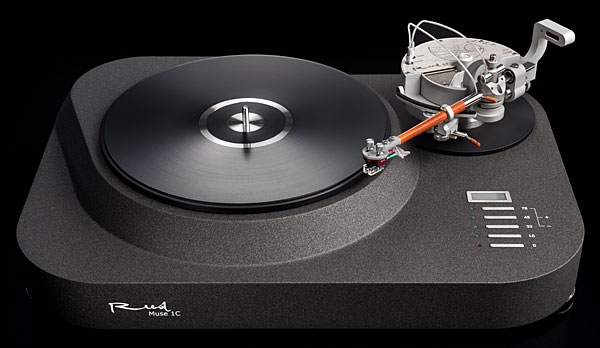
Compared to that more costly flagship 'table, the Muse 1C ($15,000) has a larger footprint and a more traditional-looking design. It weighs less—33lb vs the 3C's 55lb—and comes in either Moonlit Black or Karelian birch finishes, instead of the 3C's machined aluminum. The 1C is arguably more dramatic and attractive looking, though both models look snazzy, down to the thin leather/suede platter mats supplied with all Reed turntables.
The 1C's drive system is derived from that of the 3C and uses the same main bearing and drive system. Central to this is an aluminum subplatter machined with a tapered hub, driven by two opposing PLL (phase-locked loop)–controlled DC motors that turn at slightly different speeds; the two motor pulleys are fitted with rubber/ elastomer drive wheels of slightly different diameters. Unlike the 5C, which can be ordered, for an upcharge, with both dual "friction-wheel" drive and belt drive, the $15,000 1C can be ordered with either drive mechanism but not both.
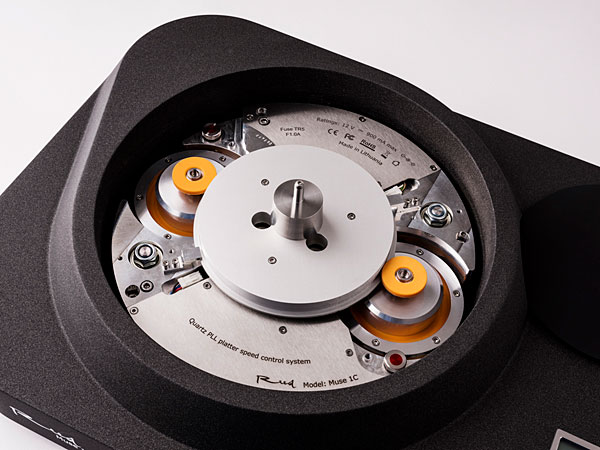
The 6lb POM platter features a large-diameter, tapered, machined-aluminum insert that fits securely over the subplatter's tapered hub to complete a stable, high-torque drive system that achieves speed quickly. The 1C plays four speeds: 16.67, 33.3, 45, and 78. The 78rpm setting can be adjusted to between 70–85rpm to accommodate the various speeds appropriate to different 78rpm records. Based on my Platterspeed app results (figs.1 & 2), the 1C's relatively light platter spins with impressive speed consistency.
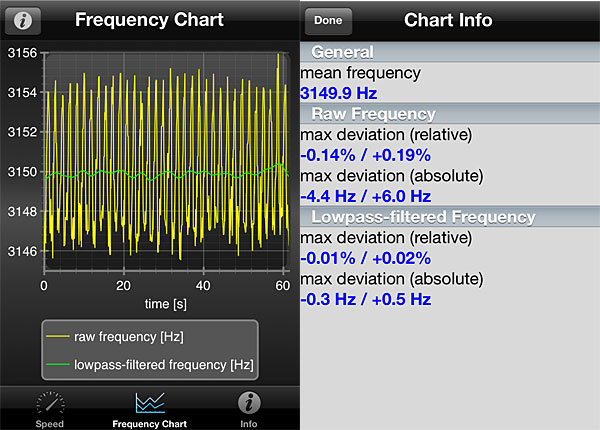
The 1C accepts only one tonearm, 9.5–12", to the 3C's two. Both models feature built-in inclinometers that allow you to easily level the 'table without using additional tools.
The pivoted, tangential-tracking 5T tonearm
The Reed 5T ($21,500) is a pivoted tonearm with a unique design that enables it to track tangentially. During record playback, a laser emitter located just below the upper vertical bearing points and a Gort-like laser sensor (footnote 2) located at the rearmost part of the arm assembly are used to track the tonearm's lateral motion; that information is used to adjust, on the fly, the position of the tonearm's lateral pivot: a correction applied in real time by means of a small, battery-powered motor in the arm-mount assembly.
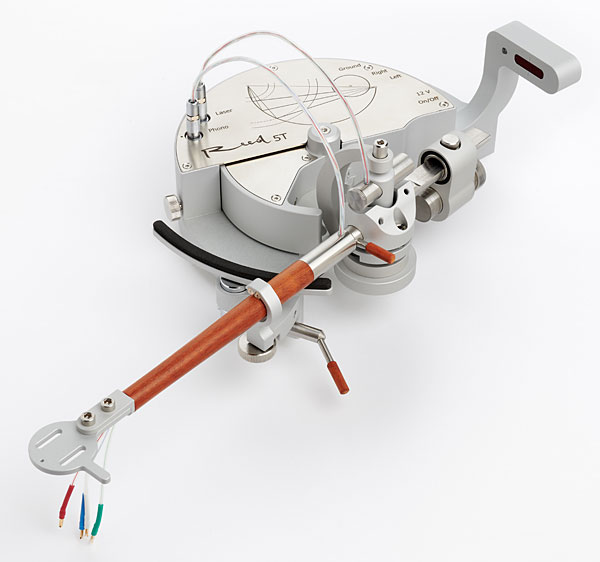
As the arm swings across the record, the player's three key points—the stylus, the tonearm pivot, and the record spindle—form a perfect right triangle in three arm positions, spaced evenly across the record's grooved area. And in each of those triangles, the stylus is at the apex of the 90° angle—and so there are three arm positions at which perfect tangency of stylus to groove is achieved, with relatively negligible lateral tracking error between those positions. Reed says the 5T's maximum error is ±5 minutes of angle—ie, approximately 1/12 of a degree—whereas standard pivoted arms usually have tracking errors of up to 1.5°. That's a big improvement.
This works because Reed designed their moving-pivot mechanism with Thales's theorem (footnote 3) in mind. The illustrations shows the geometry involved. In fig.3, P1-01-P3 is the diameter of the conceptual semicircle on which Thales's theorem depends, and the triangles formed by P1-A1-P3, P1-A2-P3, P1-A3-P3 are all right triangles. The line segments A1B1-A2B2-A3B3 represent the tonearm's wand; P2 represents the center of a circle drawn through three points—B1, B2, and B3 (the tonearm rotation axis); P3 is the linear sensor array, and B2-P3 is the laser beam. The diagram's key takeaway is that the tonearm is able to maintain the stylus with near tangency to the record grooves, not only at the three A points shown but all across the playing surface (fig.4).
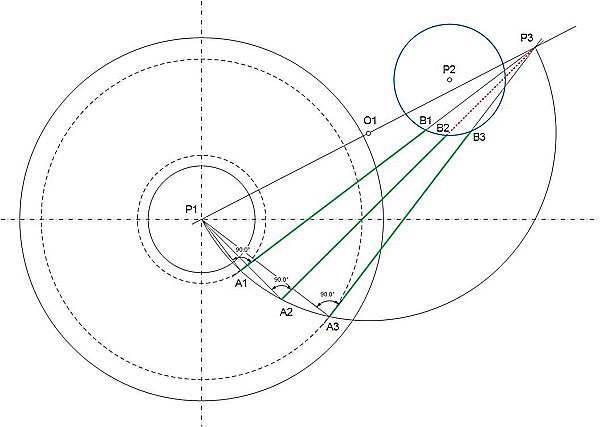
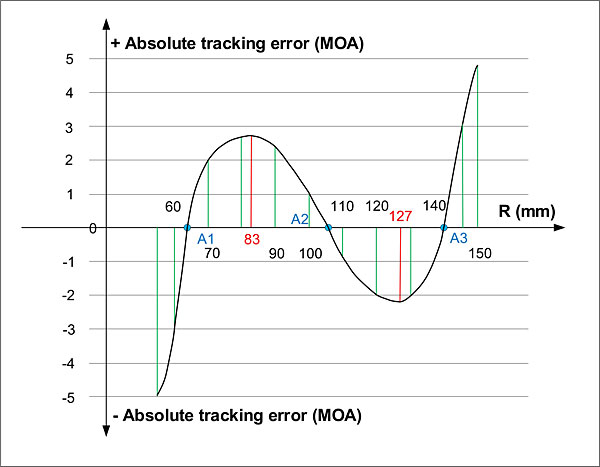
Also, compared to pivoted arms (especially unnecessarily long ones), the 5T has a smaller moment of inertia, so it tracks better. And in addition to the minimal lateral tracking error, the 5T's tangential tracking mechanism addresses antiskating concerns. Reed claims other advantages over other companies' tangential trackers: The Reed arm eschews air supplies and compressors, for example, and its effective mass, in both vertical and horizontal planes, is similar to that found in conventional arms.
The Reed 5T is available in all-opaque silver metalwork (as supplied), in black metal, and in black with gold accents. Wood options for the arm tubes include Wenge, Makassar Ebony, Cocobolo, and Teak (Light or Dark). The arm's $21,500 price may be steep, but once you see the 5T in operation, it becomes an object of desire. It performed flawlessly throughout the review period.
Installation and setup
I have quite a lot of experience setting up tonearms, but setting this one up was an exercise in frustration, for reasons partly but not entirely my fault. Even under the best of circumstances, even the most experienced analog fans are likely to find the 5T's setup challenging. Designer Vidmantas Triukas, who is obviously a genius, apparently thinks all his buyers are geniuses as well.
The instructions do a good job of explaining certain elements of setup, such as how to use a supplied plastic alignment tool for measuring pivot-to-spindle distance. But other topics aren't well-covered or are less than clearly spelled out.
When at one point I was faced with a confusing section, I emailed the manufacturer, who sent me the URL for a video on YouTube, which should have been mentioned in the instructions.
Some setup difficulties were of my own making. I didn't read the instruction manual, as the manual itself suggests, before starting to unpack things. So when I unboxed a battery power supply, I saw it had two outputs and two umbilicals. Was it unreasonable for me to assume, in the absence of instructions to the contrary, that one cable would power the turntable and the other the tonearm's servo? The umbilicals fit that way, after all. But it turned out the second umbilical is for powering a second arm—not the turntable—and when I plugged it into the turntable's power-in socket, I blew an exotic cylindrical fuse that looked a little like a capacitor. With assistance from Reed, I tracked down a source for that part and ordered a replacement. Digi-Key had it delivered the next day.
Here's a suggestion: Provide a separate, less-detailed document—just one sheet, placed at the top of the box's contents—that maps out a basic setup strategy, with a link to a video of the setup process. After the general approach has been grasped, more detailed, specific instructions would be helpful. Instead of telling us to be sure a bearing is in the "right" or "correct" position, please show us what position is right and correct!
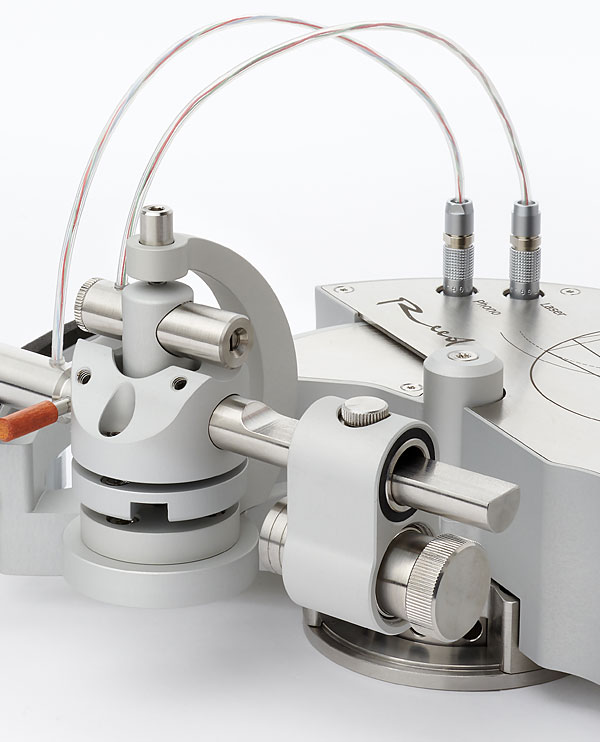
After those frustrating experiences taught me some lessons, I found setting up the arm somewhat straightforward. I say "somewhat," because the alignment tool took some getting used to; the instructions simply say "use it." With a servo in play, you have to move the arm slowly across the arc; otherwise "overload" will cause the system to stop operating. Unless you are paying attention to the blinking LED next to Gort, you won't know that.
Ultimately, I was able to set up the costly Ortofon MC Century cartridge without incident—and wowza, did it sound great with this arm/'table combo! It sounded great, that is, when I remembered to turn the tonearm on. A few listening sessions began with me thinking, "The player sounds weird today," until I realized I hadn't powered up the arm. Then, after you power up the battery supply—a fully charged battery will power the arm for 15 hours—you have to activate the servo by pushing a button behind the Gort piece.
Footnote 2: See wikipedia.
Footnote 3: If the center of a triangle's circumcircle lies on the triangle, then the triangle is a right triangle, and the center of that circumcircle lies on the triangle's hypotenuse.

I might have missed it, but was the SAT mounted on the Muse 1C or your Caliburn? One thing's for sure: the 5C is a most ingenious arm. Thanks for the excellent review.

I'd guess it's tough then to make any definitive comparisons between the performance of the Reed arm/turntable versus that of the SAT/Caliburn: different turntable, different arms, different cartridges (even if both are Ortofons). It would be quite interesting to hear how the Reed 5T (Klaatu barada nikto!) would perform mounted on the Caliburn, if possible.
If I'm not mistaken, the Caliburn uses vacuum clamping. In my experience, vacuum hold-down makes a significant improvement in the performance of any tonearm, given that it presents the arm with the flattest, firmest surface possible. It's certainly a feature that I'd never again live without. So the 5T on the Caliburn might be a real blockbuster!

I had to laugh at the arm the first time I saw a picture of it. How the hell does that thing track with the cables coming out of the top of the wand? was my first thought...lol!
Then I read how it operates. Brilliant idea and only to be improved upon as time goes by. Watch the TT R&D budgets climb at companies interested in gaining that information. :)

"The 1C plays four speeds: 16.67, 33.3, 45, and 78. The 78rpm setting can be adjusted to between 70–85rpm to accommodate the various speeds appropriate to different 78rpm records."
hr

Up until this past few days, I could have told ya how to set the anti-skating for this baby. Now? Not so much!
I know it's all about the sound, but this baby exudes fine fit 'n finish with its looks, too!

I remember seeing and hearing this Reed design on a Reed Muse 3C turntable in an ultra-high-end demo (Zellaton Reference MkII speakers driven by YS Sound monoblocks, at the High End Munich Show in 2019. Impressive.